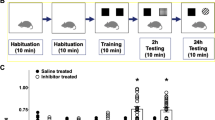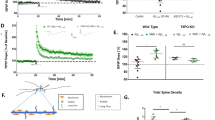Abstract
Latrepirdine (Dimebon) is a pro-neurogenic, antihistaminic compound that has yielded mixed results in clinical trials of mild to moderate Alzheimer's disease, with a dramatically positive outcome in a Russian clinical trial that was unconfirmed in a replication trial in the United States. We sought to determine whether latrepirdine (LAT)-stimulated amyloid precursor protein (APP) catabolism is at least partially attributable to regulation of macroautophagy, a highly conserved protein catabolism pathway that is known to be impaired in brains of patients with Alzheimer's disease (AD). We utilized several mammalian cellular models to determine whether LAT regulates mammalian target of rapamycin (mTOR) and Atg5-dependent autophagy. Male TgCRND8 mice were chronically administered LAT prior to behavior analysis in the cued and contextual fear conditioning paradigm, as well as immunohistological and biochemical analysis of AD-related neuropathology. Treatment of cultured mammalian cells with LAT led to enhanced mTOR- and Atg5-dependent autophagy. Latrepirdine treatment of TgCRND8 transgenic mice was associated with improved learning behavior and with a reduction in accumulation of Aβ42 and α-synuclein. We conclude that LAT possesses pro-autophagic properties in addition to the previously reported pro-neurogenic properties, both of which are potentially relevant to the treatment and/or prevention of neurodegenerative diseases. We suggest that elucidation of the molecular mechanism(s) underlying LAT effects on neurogenesis, autophagy and behavior might warranty the further study of LAT as a potentially viable lead compound that might yield more consistent clinical benefit following the optimization of its pro-neurogenic, pro-autophagic and/or pro-cognitive activities.
This is a preview of subscription content, access via your institution
Access options
Subscribe to this journal
Receive 12 print issues and online access
$259.00 per year
only $21.58 per issue
Buy this article
- Purchase on Springer Link
- Instant access to full article PDF
Prices may be subject to local taxes which are calculated during checkout





Similar content being viewed by others
References
Wu J, Li Q, Bezprozvanny I . Evaluation of Dimebon in cellular model of Huntington's disease. Mol Neurodegener 2008; 3: 15.
Lermontova NN, Lukoyanov NV, Serkova TP, Lukoyanova EA, Bachurin SO . Dimebon improves learning in animals with experimental Alzheimer's disease. Bull Exp Biol Med 2000; 129: 544–546.
Bachurin S, Bukatina E, Lermontova N, Tkachenko S, Afanasiev A, Grigoriev V et al. Antihistamine agent Dimebon as a novel neuroprotector and a cognition enhancer. Ann N Y Acad Sci 2001; 939: 425–435.
Grigorev VV, Dranyi OA, Bachurin SO . Comparative study of action mechanisms of dimebon and memantine on AMPA- and NMDA-subtypes glutamate receptors in rat cerebral neurons. Bull Exp Biol Med 2003; 136: 474–477.
Schaffhauser H, Mathiasen JR, Dicamillo A, Huffman MJ, Lu LD, McKenna BA et al. Dimebolin is a 5-HT6 antagonist with acute cognition enhancing activities. Biochem Pharmacol 2009; 78: 1035–1042.
Giorgetti M, Gibbons JA, Bernales S, Alfaro IE, Drieu La Rochelle C, Cremers T et al. Cognition-enhancing properties of Dimebon in a rat novel object recognition task are unlikely to be associated with acetylcholinesterase inhibition or N-methyl-D-aspartate receptor antagonism. J Pharmacol Exp Ther 2010; 333: 748–757.
Doody RS, Gavrilova SI, Sano M, Thomas RG, Aisen PS, Bachurin SO et al. Effect of dimebon on cognition, activities of daily living, behaviour, and global function in patients with mild-to-moderate Alzheimer's disease: a randomised, double-blind, placebo-controlled study. Lancet 2008; 372: 207–215.
Kieburtz K, McDermott MP, Voss TS, Corey-Bloom J, Deuel LM, Dorsey ER et al. A randomized, placebo-controlled trial of latrepirdine in Huntington disease. Arch Neurol 2010; 67: 154–160.
Lermontova NN, Redkozubov AE, Shevtsova EF, Serkova TP, Kireeva EG, Bachurin SO . Dimebon and tacrine inhibit neurotoxic action of beta-amyloid in culture and block L-type Ca(2+) channels. Bull Exp Biol Med 2001; 132: 1079–1083.
Steele JW, Kim SH, Cirrito JR, Verges DK, Restivo JL, Westaway D et al. Acute dosing of latrepirdine (Dimebon), a possible Alzheimer therapeutic, elevates extracellular amyloid-beta levels in vitro and in vivo. Mol Neurodegener 2009; 4: 51.
Pieper AA, Xie S, Capota E, Estill SJ, Zhong J, Long JM et al. Discovery of a proneurogenic, neuroprotective chemical. Cell 2010; 142: 39–51.
Abrahamsen H, Stenmark H . Protein secretion: unconventional exit by exophagy. Curr Biol 2010; 20: R415–R418.
Boland B, Nixon RA . Neuronal macroautophagy: from development to degeneration. Mol Aspects Med 2006; 27: 503–519.
Yue Z, Friedman L, Komatsu M, Tanaka K . The cellular pathways of neuronal autophagy and their implication in neurodegenerative diseases. Biochim Biophys Acta 2009; 1793: 1496–1507.
Butler D, Nixon RA, Bahr BA . Potential compensatory responses through autophagic/lysosomal pathways in neurodegenerative diseases. Autophagy 2006; 2: 234–237.
Caccamo A, Majumder S, Richardson A, Strong R, Oddo S . Molecular interplay between mammalian target of rapamycin (mTOR), amyloid-beta, and Tau: effects on cognitive impairments. J Biol Chem 2010; 285: 13107–13120.
Majumder S, Richardson A, Strong R, Oddo S . Inducing autophagy by rapamycin before, but not after, the formation of plaques and tangles ameliorates cognitive deficits. PLoS One 2011; 6: e25416.
Spilman P, Podlutskaya N, Hart MJ, Debnath J, Gorostiza O, Bredesen D et al. Inhibition of mTOR by rapamycin abolishes cognitive deficits and reduces amyloid-b. PLoS One 2010; 5: e9979.
Tian Y, Bustos V, Flajolet M, Greengard P . A small-molecule enhancer of autophagy decreases levels of Abeta and APP-CTF via Atg5-dependent autophagy pathway. FASEB J 2011; 25: 1934–1942.
Sarkar S, Perlstein EO, Imarisio S, Pineau S, Cordenier A, Maglathlin RL et al. Small molecules enhance autophagy and reduce toxicity in Huntington's disease models. Nat Chem Biol 2007; 3: 331–338.
Lane RF, Shineman DW, Fillit HM . Beyond amyloid: a diverse portfolio of novel drug discovery programs for Alzheimer's disease and related dementias. Alzheimer's Res Ther 2011; 3: 36.
Jacobsen JS, Wu CC, Redwine JM, Comery TA, Arias R, Bowlby M et al. Early-onset behavioral and synaptic deficits in a mouse model of Alzheimer's disease. Proc Natl Acad Sci USA 2006; 103: 5161–5166.
Bampton ET, Goemans CG, Niranjan D, Mizushima N, Tolkovsky AM . The dynamics of autophagy visualized in live cells: from autophagosome formation to fusion with endo/lysosomes. Autophagy 2005; 1: 23–36.
Yang Z, Klionsky DJ . Mammalian autophagy: core molecular machinery and signaling regulation. Curr Opin Cell Biol 2010; 22: 124–131.
Hara K, Yonezawa K, Weng QP, Kozlowski MT, Belham C, Avruch J . Amino acid sufficiency and mTOR regulate p70 S6 kinase and eIF-4E BP1 through a common effector mechanism. J Biol Chem 1998; 273: 14484–14494.
Morissette G, Lodge R, Bouthillier J, Marceau F . Receptor-independent, vacuolar ATPase-mediated cellular uptake of histamine receptor-1 ligands: possible origin of pharmacological distortions and side effects. Toxicol Appl Pharmacol 2008; 229: 320–331.
Broe M, Shepherd CE, Mann DM, Milward EA, Gai WP, Thiel E et al. Insoluble alpha-synuclein in Alzheimer's disease without Lewy body formation. Neurotox Res 2005; 7: 69–76.
Chishti MA, Yang DS, Janus C, Phinney AL, Horne P, Pearson J et al. Early-onset amyloid deposition and cognitive deficits in transgenic mice expressing a double mutant form of amyloid precursor protein 695. J Biol Chem 2001; 276: 21562–21570.
Bharadwaj P, Verdile G, Barr RK, Gupta V et al. Latrepirdine (Dimebon™) enhances autophagy and reduces intracellular GFP-Aβ42 levels in yeast. J Alzheimer's Disease (in press).
Steele JW, Ju S, Lachenmayer L, Liken J, Stock A, Kim SH et al. Latrepirdine stimulates autophagy and reduces accumulation of α-synuclein in cells and in mouse brain. Mol Psychiatry (in press).
Wang J, Ferruzzi MG, Varghese M, Qian X, Cheng A, Xie M et al. Preclinical study of dimebon on beta-amyloid-mediated neuropathology in Alzheimer's disease. Mol Neurodegener 2011; 6: 7.
Knauer MF, Soreghan B, Burdick D, Kosmoski J, Glabe CG . Intracellular accumulation and resistance to degradation of the Alzheimer amyloid A4/beta protein. Proc Natl Acad Sci USA 1992; 89: 7437–7441.
Nixon RA, Yang DS . Autophagy failure in Alzheimer's disease-locating the primary defect. Neurobiol Dis 2011; 43: 38–45.
Yang DS, Stavrides P, Mohan PS, Kaushik S, Kumar A, Ohno M et al. Reversal of autophagy dysfunction in the TgCRND8 mouse model of Alzheimer's disease ameliorates amyloid pathologies and memory deficits. Brain 2011; 134: 258–277.
Caccamo A, Maldonado MA, Majumder S, Medina DX, Holbein W, Magrí A et al. Naturally secreted amyloid-beta increases mammalian target of rapamycin (mTOR) activity via a PRAS40-mediated mechanism. J Biol Chem 2011; 286: 8924–8932.
Acknowledgements
The work in this manuscript was used in a dissertation by JWS as partial requirement for the fulfillment of the PhD degree. JWS is a trainee in the Integrated Pharmacological Sciences Training Program supported by grant T32GM062754 from the National Institute of General Medical Sciences. MLL was supported by the Deutsche Forschungsgemeinschaft. SG and CGG are members of the Oligomer Research Consortium of the Cure Alzheimer's Fund. We acknowledge the generous support of the NH&MRC (APP1009295 to RNM, GV, SG), the McCusker Alzheimer's Research Foundation (RNM, GV), Conicyt (PFB-16 to SB), the Fidelity Biosciences Research Initiative (SJ, JL, DR, GAP), Cure Alzheimer's Fund (SG; CGG), the US Department of Veterans Affairs (SG), the NIH (P01AG10491 to SG; U01AG01483 to PS; NS045283 to CGG, R01NS060123; U54RR022220 to ZY; P30 NS061777 and S10 RR022415 to RW; and P50AG05138 to Mary Sano), the Canadian Institutes of Health Research and Alzheimer Society of Ontario (PF), and Baxter Healthcare (PS and NRR). We would also like to thank Rosilyn Kazanjian for the gift in memory of Powel Kazanjian that supported the purchase of the Luminex xMAP100/200 system. We would like to thank Loren E Khan and Justine Bonet for technical assistance in animal colony management and Dr Yun Zhong for technical support.
Author information
Authors and Affiliations
Corresponding author
Ethics declarations
Competing interests
AP is Vice President of Preclinical Development for Medivation. SG holds research grant support from Amicus Pharmaceuticals and is a consultant to the Pfizer-Janssen Alzheimer's Immunotherapy Alliance. PS and NR hold research grant support from Baxter Healthcare (both PS and NR) and Pfizer (NR). NR is a consultant for Bristol Meyer Squibb and Eisai Research. GAP is on the scientific advisory boards of Amicus Pharmaceuticals and Neurophage.
Additional information
Supplementary Information accompanies the paper on the Molecular Psychiatry website
Rights and permissions
About this article
Cite this article
Steele, J., Lachenmayer, M., Ju, S. et al. Latrepirdine improves cognition and arrests progression of neuropathology in an Alzheimer's mouse model. Mol Psychiatry 18, 889–897 (2013). https://doi.org/10.1038/mp.2012.106
Received:
Accepted:
Published:
Issue Date:
DOI: https://doi.org/10.1038/mp.2012.106
Keywords
This article is cited by
-
Extracellular vesicles from amyloid-β exposed cell cultures induce severe dysfunction in cortical neurons
Scientific Reports (2020)
-
The impact of proteostasis dysfunction secondary to environmental and genetic causes on neurodegenerative diseases progression and potential therapeutic intervention
Environmental Science and Pollution Research (2020)
-
Preserving Lysosomal Function in the Aging Brain: Insights from Neurodegeneration
Neurotherapeutics (2019)
-
Increased PKR level in human CADASIL brains
Virchows Archiv (2018)
-
Pro-neurogenic, Memory-Enhancing and Anti-stress Effects of DF302, a Novel Fluorine Gamma-Carboline Derivative with Multi-target Mechanism of Action
Molecular Neurobiology (2018)



